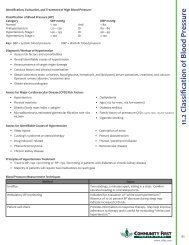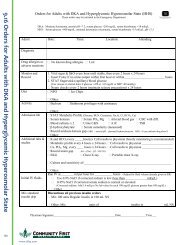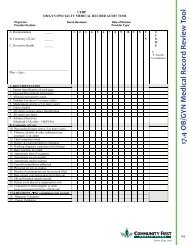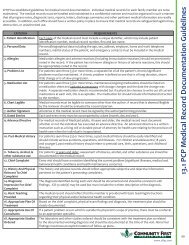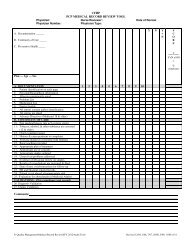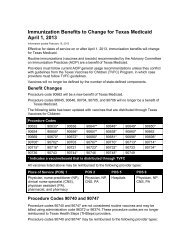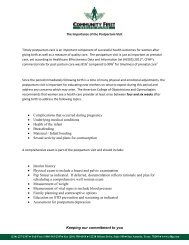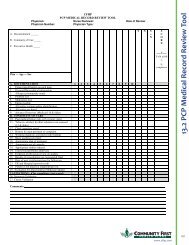Full Clinical Guidelines - Community First Health Plans.
Full Clinical Guidelines - Community First Health Plans.
Full Clinical Guidelines - Community First Health Plans.
Create successful ePaper yourself
Turn your PDF publications into a flip-book with our unique Google optimized e-Paper software.
10.4 Drugs Affecting Lipoprotein Metabolism<br />
• Consider drug simultaneously with TLC for CHD and CHD equivalents<br />
• Consider adding drug to TLC after 3 months for other risk categories<br />
Drug Class<br />
HMG CoA<br />
reductase<br />
inhibitors<br />
(statins)<br />
Bile acid<br />
sequestrants<br />
Nicotinic acid<br />
Fibric acids<br />
Agents and Daily Doses<br />
Lovastatin (20-80 mg)<br />
Pravastatin (20-40 mg)<br />
Simvastatin (20-80 mg)<br />
Fluvstatin (20-80 mg)<br />
Atorvastatin (10-80 mg)<br />
Cerivastatin (0.4-0.8 mg)<br />
Cholestyramine (4-16 gm)<br />
Colestipol (5-20 gm)<br />
Colessevelam (2.6-3.8 gm)<br />
Immediate release<br />
(crystalline) nicotinic<br />
acid (1.5-3 gm), extended<br />
release nicotinic acid<br />
(Niaspan®)(1-2 gm),<br />
sustained release nicotinic<br />
acid (1-2 gm)<br />
Gemfibrozil (600 mg BID)<br />
Fenofibrate (200 mg)<br />
Clofibrate (1000 mg BID)<br />
Lipid/Lipoprotein<br />
Effects<br />
LDL ↓18-55%<br />
HDL ↑ 5-15%<br />
TG ↓ 7-30%<br />
LDL ↓15-30%<br />
HDL ↑ 3-5%<br />
TG No change or<br />
increase<br />
LDL ↓5-25%<br />
HDL ↑ 15-35%<br />
TG ↓20-50%<br />
LDL ↓5-20%<br />
(may be increased in<br />
patients with high TG)<br />
HDL ↑ 10-20%<br />
TG ↓20-50%<br />
Side Effects<br />
Myopathy<br />
Increased liver<br />
enzymes<br />
Gastrointestinal<br />
distress<br />
Constipation<br />
Decreased absorption<br />
of other drugs<br />
Flushing<br />
Hyperglycemia<br />
Hyperglycemia (or<br />
gout)<br />
Upper GI distress<br />
Hepatotoxicity<br />
Dyspepsia<br />
Gallstones<br />
Myopathy<br />
Contraindications<br />
Absolute:<br />
• Active or chronic liver<br />
disease<br />
Relative:<br />
• Concomitant use of<br />
certain drugs*<br />
Absolute:<br />
• dysbetalipoproteinemia<br />
• TG > 400 mg/dL<br />
Relative:<br />
• TG > 200 mg/dL<br />
Absolute:<br />
• Chronic liver disease<br />
• Severe gout<br />
Relative:<br />
• Diabetes<br />
• Hyperuricemia<br />
• Peptic ulcer disease<br />
Absolute:<br />
• Severe renal disease<br />
• Severe hepatic disease<br />
Cyclosporine, macrolide antibiotics, various anti-fungal agents, and cytochrome P-450 inhibitors (fibrates and niacin should be used<br />
with appropriate caution).<br />
Taken from NCEP Expert Panel. Executive Summary of the Third Report of the National Cholesterol Education Program(NCEP) Expert<br />
Panel on Detection, Evaluation, and Treatment of High Blood Cholesterol in Adults (Adult Treatment Panel III ). Bethesda, Md: National<br />
Heart, Lung, and Blood Institute, National Institutes of <strong>Health</strong>; 2001. NIH publication 01-3670.<br />
88 H EALTH PLANS<br />
www.cfhp.com



